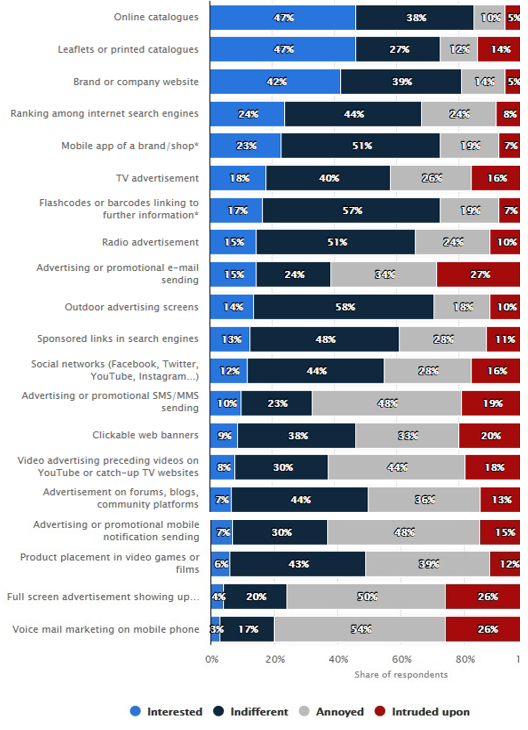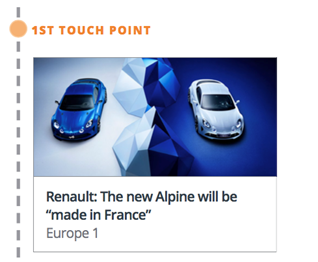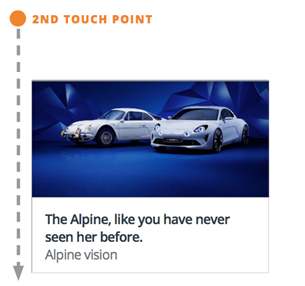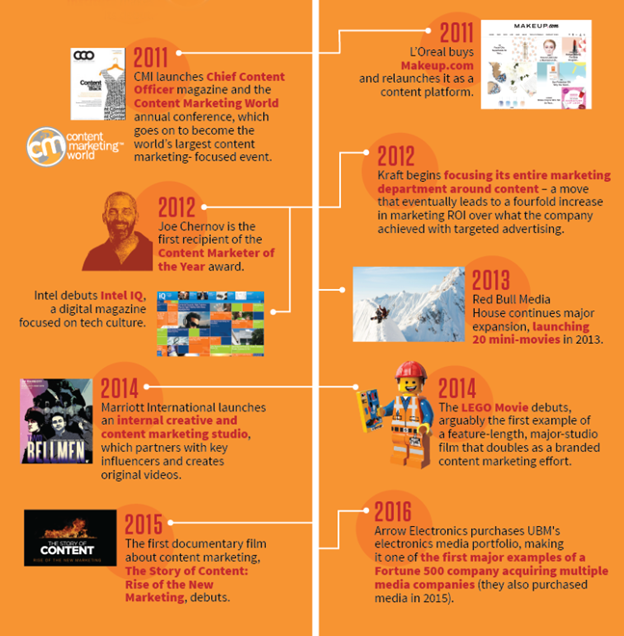Content Marketing in France
- CONTENT MARKETING: OVERVIEW
The concept of promotion permeates content marketing practice. In a notable distinction between content marketing and conventional marketing methods (e.g. paid TV & Radio advertising, in-print sponsored editorials and sports events billboards), content marketing is distinct in scope and penetration. More specifically, while more conventional promotion practices remain largely constrained by adopted medium, budget and/or corporate marketing strategy, content marketing is remarkably effective across different marketing communications channels, engaging in message and medium and, not least, participatory in nature.
The growth of content marketing in adoption and influence can be attributed to several practice-specific and broad sociocultural factors. In practice, marketing practice has outgrown a conventional status of being a “periphery” to being central to business practice (Gordon & Perrey, 2015). This growing importance of marketing has put the content at the center of promotion message. The established French luxury brand Chanel has, for example, adopted for decades a more conventional approach to promoting different brand offerings including fashion weeks, film festivals and in-store events. The iconic lead designer at Chanel, Karl Lagerfeld – established as he is in a more conventional promotion culture – has, however, recently launched a successful multi-channel campaign promoting a new No. 5 perfume including the formerly unheard-of promotion of Chanel’s behind-the-scenes movie-making. The campaign has later been extended to include short films over different social media platforms including YouTube (Gordon & Perrey).
Socioculturally, content marketing appears to respond to a broader shift in consumer preferences and habits. In contrast to the more conventional practices by which communication is one way, content marketing is shown to evolve into a practice which satisfies a growing need, particularly among younger segments (aka Millennials), to participate in storytelling (Pulizzi, 2012). Moreover, content marketing is shown to have a more engaging potential compared to the conventional marketing and promotion methods by enabling consumers / users to participate not only in message creation but, probably more importantly, in the meaning-making of brands (Ashley & Tuten, 2015). Moreover, Ashley and Tuten (2015) show that brands, particularly consumer brands, adopt more functional appeals compared to experiential and participatory appeals in order not to burden consumers cognitively. This finding is, however, not supported in the current project. The case for the French brands and consumers is shown, in the current research project, to adopt a retro approach which, in English-speaking countries, is viewed as low-tech and at best unengaging. In France, content marketing practice is adopted, more specifically, to engage consumers at a deeper, not at a broader level.
To better understand how content marketing exercises a deep influence in France, at corporate and consumer sides, a closer examination is required of content marketing practice in France. To do so, content marketing is, first, discussed in a broad, historical context. The subsequent analysis is, second, devoted to a more in-depth analysis of specific content marketing practices and cases in France. This paper aims, hence, to examine how content marketing, as one form of marketing communications, is shaping corporate marketing practices and consumer habits and preferences in profound ways in France.
- CONTENT MARKETING: A BRIEF HISTORY
In concept, content marketing is not new. Indeed, for millennia humans have engaged in content marketing activities if content is understood as a message delivered over one or more communication media (Pulizzi, 2016). The contribution of content propagators cannot be overemphasized. The engagement methods adopted by different content propagators have, moreover, differed according to adopted or available communications media, recipients and dominant sociocultural habits and customs. For current purposes, select contributions by specific content propagators are briefly discussed in order to highlight distinct French content marketing practices.
The French business has early contributions to content marketing. In 1801, Librairie Galignani, a Paris-based bookstore, opened a reading room, created original books and published a house newspaper featuring influential authors. In 1900, Michelin developed what is now an iconic French-cuisine and accommodation guide, The Michelin Guide, initially to help drivers find better lodging while traveling and now is regarded as a major reference guide to world-class chefs. In 2001, L’Oréal purchased makeup.com, which was later relaunched as a content platform (Content Marketing Institute, n.d.). (L’Oréal represents a unique case of content marketing and is discussed in further detail under “Content Marketing in France: The Social Impact” section.)
For a fuller account of content marketing history, refer to Figures 4,5 and 6 in Appendix.
III. CONTENT MARKETING IN FRANCE: THE CURRENT STATE OF PRACTICE
The practice of content marketing is gaining more foothold in France. This is evident not only in how consumers are shifting attention more and more to web-based and mobile marketing media communication channels, as shown in Figure 1 below, but also to content marketing practice which is maturing more and more. For example, the Branded Content Marketing Association (BCMA), a global network of content marketing professionals, has an active chapter in France, BCMA France whose main mission is to “to build a connected, engaged and active community for Branded Content professionals throughout France” (“About,” n.d.a). Interestingly, BCMA France is headed by Thomas Jamet, a seasoned content marketing executive and entrepreneur who has helped launch one of Air France’s most successful multi-channel campaigns, “Air France, France is in the air.” (More in-depth discussion of “Air France, France is in the air” follows under “Content Marketing in France: The Social Impact” section.)
Characteristically, French consumers are more likely to adopt direct marketing communications channels. As shown in Figure 1 below, respondents are engaged more by online catalogues (47 %), leaflets or printed catalogues (47) or brand website (42%) compared to lower interest in mobile-based communications (3%) and even lower interest in social media platforms (12%). This characteristic feature of consumer engagement in France is discussed in several case examples under “Content Marketing: The Influence on and for France” and “Content Marketing in France: The Social Impact” section” sections.
Figure 1. Attitudes to advertising and marketing media in France. (Statista, n.d.)
- CONTENT MARKETING: THE INFLUENCE ON & FOR FRANCE
The content marketing practice in France is counterintuitive to English-speaking practitioners. In France, web and mobile platforms are harnessed not to amass more followers or friends, as in English-speaking countries, but to penetrate everyday life of French consumers for deeper, more engaging and long-lasting relationships. The surveyed respondents in Figure 1 above, offer a hint into how content marketing is employed in a French content marketing context. At a deeper level, however, why established French brands, as shown in case examples under “Content Marketing in France: The Social Impact” section, choose a more personalized approach to content marketing can be best characterized as follows:
The desire to engage with customers on a personal level is particularly prevalent in France. Although internet use by the French has increased markedly over the years, it still lags behind use in other Western countries. Just 63% of households in France now have internet access, compared with 74% in the United States, 77% in the UK, and 79% in Germany. The French lag in their use of social networking sites, too. In 2008, only 20% of them visited such sites. In 2009, their number jumped to 36%, but that tally still left France behind the UK (43%), Spain (52%), and Italy (59%). (Kramer, 2010).
The case for fewer but deeper, and not broader, consumer engagement in France has proven successful in several instances. The call center has, paradoxically, shown to be particularly effective in not only engaging consumers of Nespresso France but also to help promote the brand’s products and image via word-of-mouth, digital or not. The success to engage customers and win a constant buy-in has been possible by going beyond conventional Q&A customer engagement approaches in call centers into more prolonged conversations about almost about everything customers need to know about Nespresso France, including the company’s carbon footprint (Kramer, 2010). Tapping into a combination of low-tech and high-tech solutions proves far more effective, or influential, in engaging different French consumer segments. This ability to combine digital and conventional content marketing methods is consistently and successfully adopted by L’Oréal, a case discussed in further detail under “Content Marketing in France: The Social Impact” section.
Two concepts need to be highlighted, however, before moving on. The first concept is social influence. Tapping into a recent, exponential growth in social media platforms, social influence has become a standard branding label adopted by the most active users of social media platforms and, for that matter, advertisers (Gershbein, 2017). To help promote a specific product or service, brands are now embracing social influencers to influence not only the purchasing habits of but also, more importantly, the perception of brands by consumers. The “employment” of social influencers by brands cannot be overemphasized in image-oriented industries including, fashion and beauty, airline and auto industries.
The second concept is branded content storytelling. Contrary to conventional storytelling offerings developed and owned by the advertising agencies, branded content storytelling is about a close collaboration between brands and agencies to develop an evolving story across multiple marketing communications channels in which the end consumers are primary participants (Raunio & Arhio, 2015). As shown by Pulizzi (2012) and Ashley and Tuten (2015), corporate content marketing practices are shifting increasingly from a one-way communication form to dual or multiple channels via which consumers do not only contribute to a product / service features or image but are engaged more and more in creating whole new product and service concepts. The concept of storytelling cannot be overemphasized for French Millennials, an emerging marketing segment whose influence on brand perception mediated via web-based, personalized engagements (and less so via mobile and social media platforms) is projected to inform content marketing, if not marketing practice overall, for decades to come. In France, although Internet penetration remains relatively lower compared to Western countries and the interest by younger consumer segments in social media platforms is even lower, deepness of the engagement is what matters.
The following section highlights a number of French content marketing cases in which brands, consumers and influencers engage in a constant, open conversation across multiple marketing communication channels at a deeper level.
- CONTENT MARKETING IN FRANCE: THE SOCIAL IMPACT
France is, arguably, an aesthetics-oriented country. Through fashion, beauty and service industries, France projects internal and external images combining long-standing heritage and constant innovation. Three case examples are selected to showcase how, via personalized storytelling and branded content marketing, brands pervade French markets and culture. These are: L’Oréal, Renault and Air France.
- I. L’ORÉAL: THE CASE FOR SOCIAL INFLUENCE
L’Oréal is an established, French beauty brand. Historically, L’Oréal has invested in brand image – just as all beauty and fashion brands, particularly in France, do – by engaging consumers via a broad range of marketing communications channels including fashion weeks, glossy in-print publications and paid TV advertising. In recent years, however, L’Oréal has continued to increase her digital investments, at 30% of overall media budget in 2016, hoping to engage Millennial consumers using video advertising, online influencers and personalized communications and recommendations (Great Speculations, 2017). In a remarkably French style, L’Oréal empowers consumers and stakeholders by listening. For example, in addition to integrated branded content campaigns, L’Oréal chooses to give consumers and influencers a voice via an independent platform, FAB Beauty (Hall, 2016). Consistent to, if not in response to, a French cultural inclination, L’Oréal, in a way much similar to Nespresso France, engages consumers in prolonged conversations which aim to secure a buy-in of L’Oréal’s products and image. Indeed, FAB Beauty is hardly a branded content platform and offers no e-commerce value. The mission statement, if any, of Fab Beauty is as follows:
FAB Beauty is the new online media showcasing beauty professionals. FAB Beauty takes a look at salons, setting out to discover artisans of beauty and their expertise. This platform deciphers the current trends created by professionals all over the world and highlights the men and women who transform the business every day. (“About,” n.d.b)
Thus, by offering an enduring, user-driven platform, L’Oréal builds a business case of a long-lasting social influence. In a country obsessed about fashion, a “free” hub at user’s own discretion is nothing short of an extremely influential content marketing channel.
V.II. RENAULT: THE CASE FOR SEQUENTIAL STORYTELLING
Renault is, similar to L’Oréal, a well-established French brand, albeit in the auto industry. Typically, Renault is well known for functionality and a non-premium status. The decision by Renault to relaunch an old sports model, Alpine, has required a more aggressive content marketing strategy. Compared to Ferrari, Lamborghini, Audi, BMW, and Mercedes, Alpine has had no chance to engage French consumers, let alone securing buy-ins. By adopting a sequential storytelling approach, Renault has been able, however, to engage consumers along powerful touchpoints based on a 2-step content strategy (Le Lausque, 2016).
Figure 2. First step in Renault’s content strategy. (Le Lausque, n.d.a)
Figure 3. Second step in Renault’s content strategy. (Le Lausque, n.d.b)
The first step, shown in Figure 2, involves driving consumer awareness by emphasizing a “Made in France” message right after the initial announcements of relaunching Apline. This first step has resulted in 55,000 pre-qualified visitors to different digital platforms. The second step, shown in Figure 3, involves deeper engagement of interested, or pre-qualified, visitors by reinventing Alpine’s image via articles and multimedia content available on the corporate website (Le Lausque, 2016).
Thus, in order to regain a lost reputation of a sports car in a highly competitive industry, Renault has relied – again – on a French-specific engagement style: listen (attentively) first and engage second.
V.III. AIR FRANCE: THE CASE FOR BRANDED CONTENT
In a content marketing offensive, Air France has embarked on a series of aggressive and highly successful marketing and promotion campaigns. In 2014, “Air France, France is in the air” was launched across several in-print, web, social media and radio communications channels. Developed by BETC France, “Air France, France is in the air” combines French heritage and modernity (West, 2014). In 2015, a separate film, “France is in the air,” was developed by BETC France further immersing viewers in a custom, stylized cabin including ballerinas, the Tour de France, a high-fashion photo shoot, pastries and young lovers (Gianatasio, 2015).
On 16-17 February 2017, Air France organized a Junior Lab. In a notable attention to Millennials, aka Generation Y or Z, Air France offered an open space for Millennial participants to share different ideas on how to optimize flying experiences (Air France, 2017). From a marketing communications perspective, Air France did not only offer a platform for participants or consumers to participate in a corporate-consumer conversation but also to create corporate messages and, more importantly, to propose innovative solutions to flying experiences. This is not to mention a recent music content marketing initiative, “Music in the Sky,” a free iPhone application, by which passengers or consumers can hold the phone heaven-ward, pan the sky until capturing a musical note icon onscreen and finally click the icon to listen to the captured note (Kent, 2012).
- FUTURE DIRECTIONS & POTENTIAL SOCIAL IMPACT
The future holds both predictable and unpredictable patterns for content marketing practice and social influence in France. The predictable patterns include the continuation of current slow adoption of mobile and social media platforms as primary consumer engagement marketing communications channels. This projection is informed by the established cultural habits and usability patterns of web and mobile media in France, particularly habits emphasizing direct, deeper and more personalized communications or encounters.
The unpredictable patterns might include an acceleration of mobile and social media platforms adoption in France. The demographic changes, combined by an emerging powerful market segment, i.e. Millennials, are apt to introduce deeper changes in French culture and lifestyle. This projection is based on the current content marketing strategies adopted by L’Oréal, Renault and Air France to approach and engage Millennial consumers.
Appendix †
Figure 4. A brief history of content strategy. (Content Marketing Institute, n.d.)
____________________________
† This appendix includes an infographic which is reproduced in Figures 4, 5 and 6 instead in one extended poster form, as in original format, for better content visibility.
Figure 5. A brief history of content strategy. (Content Marketing Institute, n.d.)
Figure 6. A brief history of content strategy. (Content Marketing Institute, n.d.)












